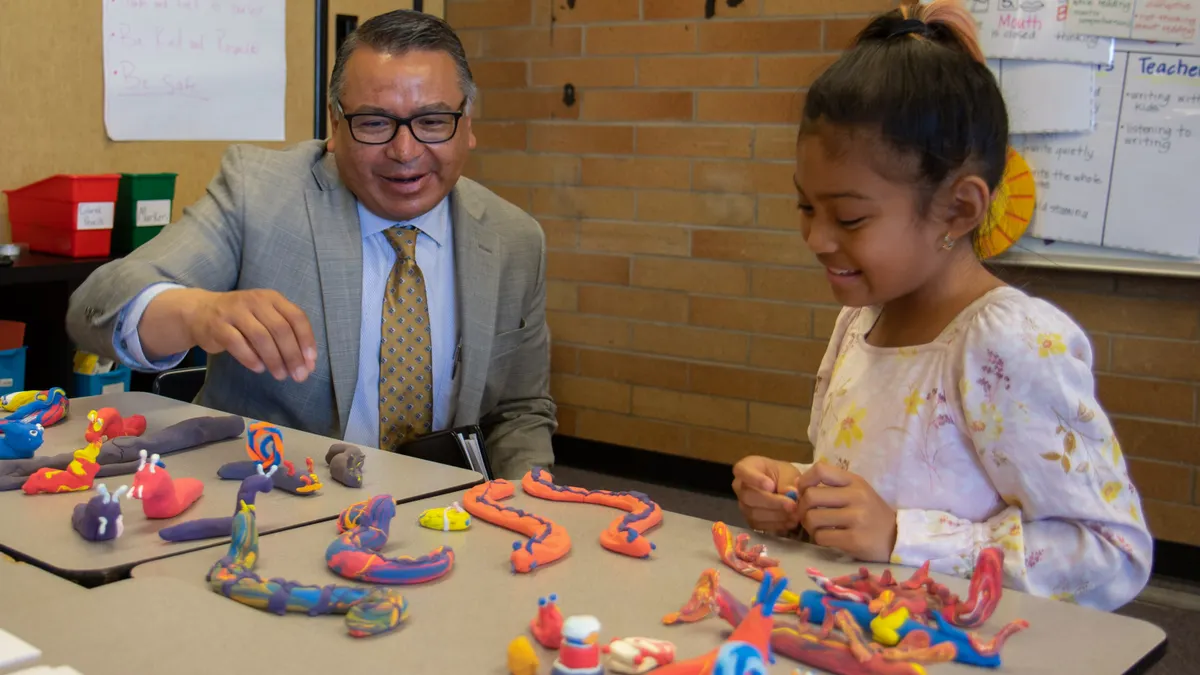Amid the implementation of Stephenville Independent School District's "iChampion" 1:1 initiative, Director of Digital Learning Brianna Hodges has ensured amid that strong pedagogy remain the focus in her rural Texas schools. As a former middle school English teacher with a master's in curriculum, focused on instructional design and technology, Hodges knows all too well that importance.
At SXSWedu, Education Dive caught up Hodges, who serves as the Instructional Coaches "strand adviser" for the Future Ready Schools initiative and oversees her district's induction into Digital Promise's League of Innovative Schools. We asked about Stephenville's tech rollout, the importance of pedagogy and inspiring the next generation of students.
EDUCATION DIVE: As a rural district, what sort of concerns did you have as far as students’ internet access outside of school?
BRIANNA HODGES: It’s really interesting, because a lot of times when we talk about equity and access, the conversation tends to go to socioeconomics — and that’s absolutely very much the case in many situations. But in rural situations, it’s also more of a logistical access. There are true places in our school district where they’re just not able to get internet access. What we’ve done is partner with companies all over town who have sponsored buses for us.
We have students who are always traveling to represent our schools [in athletics and extracurricular activities], as well as we have students who are on bus rides for a long time on daily routes. What we realized was if we could get them access on maybe an hour-and-a-half bus ride, they would be able to get their homework finished there. Most of our students who are more difficult to provide internet for logistically are riding buses, so that was a really great way to provide that. We did a lot of surveying ahead of time to really try to hone in on where those students were and how we could best help them.
Another thing we did with our community partnerships is create what we call iChampion WiFi spots. We have a really strong community base of support, and people are really proud in our town to support our school district. In this day and age, a lot of businesses are providing free WiFi for their clientele, so we decided to kill two birds with one stone and went to them and said, “Are you providing free WiFi?” “Yes.” “Do you mind if we get you a sticker that says ‘iChampion HotSpot’ and put it on the door?” As a business, they were able to showcase their support for the community and the school district, and it allowed us to help provide a location map for students to meet up to work on projects or try to have those study places.
I’m sure there are always ways to improve the situation, but those have been our “quick wins” that we were able to capitalize on as we went through it.
In any sort of tech rollout, how important is it to ensure pedagogy stays front-and-center?
HODGES: It is the linchpin to implementation. I’ll say that there are many, many school districts out there that have been in 1:1 environments or X:1 environments for a number of years — some approaching a decade-plus. One of the benefits to waiting a little bit is to see and learn what has happened for other districts along the way, and what’s been successful and what hasn’t.
It’s been a huge opportunity for us, as we’ve been fortunate enough to go on site visits through Digital Promise. I’ve been fortunate enough to travel all over the country and see different things firsthand, what works well and what doesn’t. Hands down, one of the things we’ve seen over and over again is when you put the focus on the technology, that’s like saying, “We’re gonna work on how to sharpen a pencil really, really well before you go into the classroom.”
You’ve put the focus on the wrong part of the student when you’re just saying, “All we’re gonna do is this tool.”
By having this great team of pedagogically strong teachers, it has allowed us to focus on why we are doing this. A lot of times you get pushback of, “You’re just adding technology because it’s the new shiny thing,” or whatever. But when we focus on pedagogy, you’re really, truly able to say, “No, this is why we’re doing this.”
A lot of times we get pushback from people saying you’re replacing what best practices have been. “We still want our students to write, we still want our students to do this.” Absolutely, they should. They should be writing, they should be drawing, they should be doing all these different things. But what’s the element that comes beyond that?
I work a lot with our 1st- and 2nd-grade teachers, and, absolutely, writing things out and expressions of creativity are really, really important. But I ask them after they have this demonstration where students have written this story or they’ve written this paragraph or they’ve illustrated their idea about this, what if we brought this into another platform where now they get to narrate why they did this and explain the thinking behind it? Now we’ve taken it from just, “OK, we’ve written this story,” to now it’s the “behind the scenes music tour” kind of idea. Narrating these pieces then brings in a layer of experience and connection for these kids that’s super important.
That’s a very long answer to say that if you don’t know why you’re implementing something in your classroom, it’s really, really hard to get actual implementation, and the best way to do that is to know pedagogically why you’re doing that.
With the attention given to the lack of women in STEM fields, and as a woman who works in a tech-related position, how important is it to you that you’re in a position where you can serve as a role model that female students can look at and say, “Oh, this is something I can do, too?”
HODGES: It’s really interesting. There’s a lot of truth, and you hear it said a lot, that if you don’t see who you are as a person in roles you aspire to, you start to believe you shouldn’t be in that role. This answer is a sticky one for me in a lot of ways, because I push back a lot on the idea of — I’ll be the first to tell you I don’t consider myself a “technology person.” I’m not the person who, “Oh my gosh, I coded my first computer.” I don’t get excited about wires and trying to make them light up and do all these different things. That wasn’t what my background was. Where I became a “technology person” was in my job as a marketing person. My connection to technology is more from a storytelling perspective than it is from a zeroes-and-ones perspective.
That’s not to say that it’s not super-important. I think that our students need to understand what all is encompassed in a job in order to understand that they’d be good for it. A few weeks ago, I asked a math teacher what does a student who’s really good at math look like when they’re 15 or 16, and we talked about that. And then, OK, what does someone who’s 25 or 30 look like who’s really good at math? What skills do they have? What are they doing? How do you know that they’re really good at math?
Oftentimes, when we characterize that as a high school student or a K-12 student of any kind, it’s because they got all of the odd problems on page 23 correct, and that showed that they were really good at math. They knew the concept. Fast forward to 25 or 30, nobody’s sitting down and opening a textbook and copying those problems and showing their work to show that they know what they’re doing. What are those jobs and how do they know?
It can run the gamut, right? You can be an amazing construction engineer. You can also be the foreman for a roofing company who can sit there and flip over a piece of plywood and draw out the angle proportions of what the pitch needs to be in order to do this. That same person, if you walked up to them and said, “Hey, how did you do at math in high school?” They may tell you, “I was in every challenging opportunity for math,” or they may tell you, “I was not good at math. This was not my forte at all.” But they’re compelled to do it because now they have authentic experience with it.
I say all of that because I think what is missing a lot in our education is the opportunity to not be defined by a standard of learning, but to instead be inspired by an experience of learning. What could that look like in a math classroom? Instead of asking them to draw out angles, could it be that we’re going to take the blueprint of a house and take it on a reduction to a dollhouse? “How would your proportions look? What would this look like? Can you actually construct it? Let’s make it supported? Will it hold weight? Will it do all these different things?”
Does that bring it home more to kids than drawing out the X and Y and looking at it that way?
That’s one answer to that. The other answer is I think one of the things that’s interesting in education is people often say education typically, historically, has been more predominately female in gender. I think that can be perceived as true in certain ways, but I also think it’s very interesting if you look at it through an influence filter, oftentimes you see a gender shift in the scope of influence as you go up.
You might have more female teachers, but how does that come into principals? How many females then become principals, and how many females go from principal to superintendent? How many females go from superintendent into thought leadership roles and into political advocacy and those kinds of things? You start to see those numbers very much wane, so how do we encourage that voice to keep coming along the way?
I think it’s super important to listen and to contribute to that voice and see that you’re not just. You can’t look at a kid and say, “I’m just a kid. I don’t know what I’m doing.” Nobody would take that. You’d push on that and say, “No, you’re important. You’re inspirational. You have all this.” Why do we feel less like that when we get older, you know?





 Dive Awards
Dive Awards












